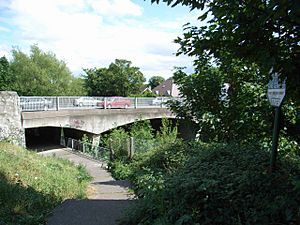Austin Clarke (poet) facts for kids
Austin Clarke (Irish: Aibhistín Ó Cléirigh) was an important Irish poet. He was born in Dublin, Ireland, on May 9, 1896, and passed away on March 19, 1974. He was one of the main poets who came after the famous W. B. Yeats. Besides poetry, Clarke also wrote plays, novels, and books about his life.
Austin Clarke was known for how carefully he used special writing techniques. He borrowed these methods from old Irish language poetry when he wrote in English. This meant his English poems used unique sound patterns. He focused on things like assonance (repeating vowel sounds) and consonance (repeating consonant sounds). He also used half rhyme, where words sound similar but don't quite rhyme. He once told another poet, Robert Frost, that writing was like loading himself "down with chains and try[ing] to wriggle free." This shows how challenging he made his writing style.
Contents
Early Poems and Influences
Austin Clarke's first poems showed that he was greatly influenced by W. B. Yeats. His very first book, The Vengeance of Fionn, was a long poem that retold an old Ossianic legend. This book was very popular and even had a second edition, which was unusual for a first poetry book.
Before 1938, Clarke published several more collections of poems. These early works were still very much influenced by Yeats. However, there was one big difference: Clarke was Catholic, unlike Yeats. Because of this, his early poems often explored feelings of guilt and trying to make things right.
Years in Theatre
Between 1938 and 1955, Austin Clarke did not publish any new lyric or narrative poems. During this time, he helped start the Lyric Theatre, Dublin. He wrote many plays in verse for this theatre. He also worked as a journalist and had his own weekly poetry show on RTÉ radio. It seems he went through a difficult time in his personal life during these years. This period had a big effect on the poems he would write later.
Return to Writing Poetry
Clarke started publishing poetry again in 1955 with his collection called Ancient Lights. He continued to write and publish many poems for the rest of his life. Even though he still used the same techniques from Gaelic poetry, his later work was quite different from his earlier poems.
He also published a very personal poem sequence called Mnemosyne Lay in Dust. This poem tells the story of a fictional character named Maurice Devanes. It describes a period of illness and how he slowly got better.
Clarke also started to admire the work of new and experimental poets. These included Ezra Pound and Pablo Neruda, and he even wrote poems about them. Some of his later long poems, like Tiresias from 1971, show how studying these poets changed his style. He began to use more free and less strict ways of writing poems.
To publish his own work, Clarke started his own company called the Bridge Press. This allowed him the freedom to publish poems that other mainstream Irish publishers might not have wanted to print. His Collected Poems was published in 1974, and a Selected Poems came out in 1976.
Other Books and Writings
Besides his many poetry books and plays, Austin Clarke also wrote three novels. These were The Bright Temptation (1932), The Singing Men at Cashel (1936), and The Sun Dances at Easter (1952). All of these novels were not allowed to be sold in Ireland by a board that decided what books could be read.
He also published two books about his life: Twice Round the Black Church (1962) and A Penny in the Clouds (1968). He wrote many critical essays and book reviews too. While all these writings are interesting, Austin Clarke is most famous for his poetry.
Family Life and Legacy
In 1920, Austin Clarke married Cornelia (Lia) Cummins. This marriage lasted only a few days. He later met Norah Esmerelda Patricia Walker (1900–1985). They had three sons together and married in 1945. Norah was the granddaughter of Matt Harris, who was a Member of Parliament for East Galway.
Clarke lived in Bridge House, which was next to Templeogue Bridge in the south Dublin area of Templeogue. This bridge crossed the River Dodder. After he passed away, there was an idea to save his house and his large library of 6,500 books as a memorial. However, this was not possible because there were plans to knock down the house and make the road wider.
The old Templeogue Bridge, built in 1800, and Bridge House were removed. A new bridge was opened on December 11, 1984. This new bridge was renamed Austin Clarke Bridge in his honor, so his name lives on in Dublin.
Images for kids



